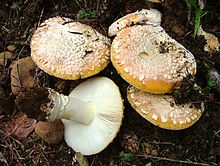Amanita aprica
Appearance
| Amanita aprica | |
|---|---|

| |
| Scientific classification | |
| Domain: | Eukaryota |
| Kingdom: | Fungi |
| Division: | Basidiomycota |
| Class: | Agaricomycetes |
| Order: | Agaricales |
| Family: | Amanitaceae |
| Genus: | Amanita |
| Species: | A. aprica
|
| Binomial name | |
| Amanita aprica J.Lindgr. & Tulloss (2005)[2]
| |
| Amanita aprica | |
|---|---|
| Gills on hymenium | |
| Cap is flat or convex | |
| Hymenium is free | |
| Stipe has a ring and volva | |
| Spore print is white | |
| Ecology is mycorrhizal | |
| Edibility is poisonous | |
Amanita aprica, also known as the sunshine amanita,[3] is a species of fungus in the family Amanitaceae. Described as new to science in 2005, the species is found in the Pacific Northwest region of North America, where it grows in a mycorrhizal association with Douglas-fir and pines.[2]
The species has a yellow to orange cap with warty remnants of the whitish universal veil. The gills are pale, as is the stipe, which may be wider at the base. A skirt-like ring may be present, especially on younger specimens.[4]
See also
References
- ^ Siegel, N. (2021). "Amanita aprica". IUCN Red List of Threatened Species. 2021: e.T195921702A195927112. doi:10.2305/IUCN.UK.2021-2.RLTS.T195921702A195927112.en. Retrieved 18 November 2021.
- ^ a b Tulloss, R.E.; Lindgren, J.E. (2005). "Amanita aprica –- a new toxic species from western North America". Mycotaxon. 91: 193–205.
- ^ "Standardized Common Names for Wild Species in Canada". National General Status Working Group. 2020.
- ^ Trudell, Steve; Ammirati, Joe (2009). Mushrooms of the Pacific Northwest. Timber Press Field Guides. Portland, OR: Timber Press. p. 81. ISBN 978-0-88192-935-5.


